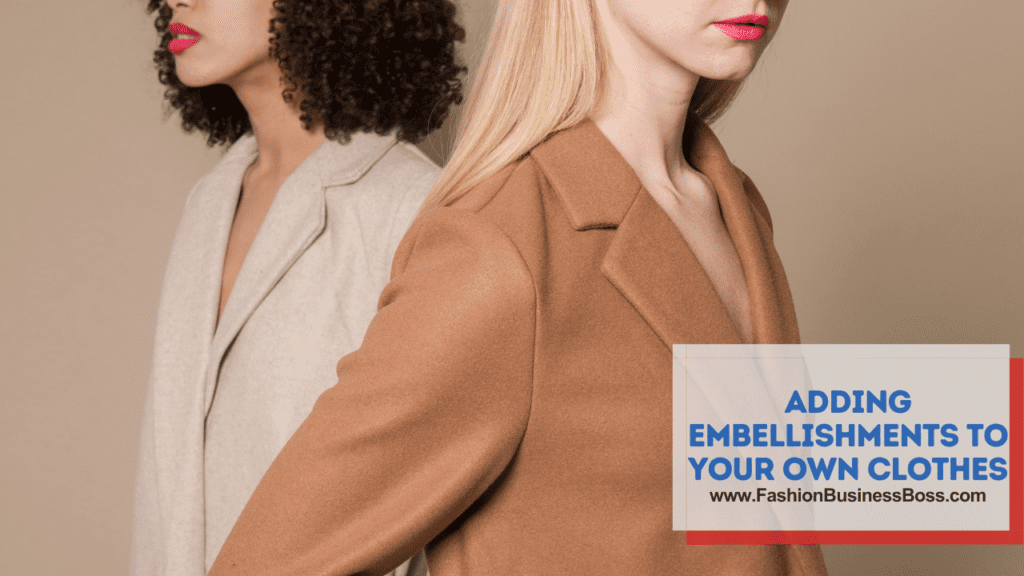The art of designing your own clothes is a creative and fulfilling endeavor that allows you to express your unique style and personality. Whether you’re a seasoned seamstress or a beginner with a passion for fashion, the possibilities are endless once you start making your own clothing designs.
To create your clothing designs, gather inspiration, research trends, draft meticulously, choose fabrics wisely, take precise measurements, add embellishments, experiment with color, and ensure quality.
In this article, we will guide you through the exciting process of creating your own clothing masterpieces.
Inspiration and Research

To embark on the journey of designing your own clothing, it’s crucial to start with a solid foundation. Begin by seeking inspiration from a wide array of sources. Flip through fashion magazines, scroll through Pinterest, browse Instagram, or even take cues from the beauty of nature and art. This diverse range of influences can spark your creativity.
Next, delve into research. Stay informed about the latest fashion trends and styles. Explore what’s currently popular in the fashion world. This research will help you understand what resonates with people and what’s in demand.
By combining inspiration and research, you’ll be equipped with a comprehensive understanding of the fashion landscape. This knowledge will serve as the bedrock for your clothing design endeavors, allowing you to craft pieces that capture the essence of contemporary style while reflecting your unique vision. So, let your creativity flow and your research guide you as you embark on your journey to design your very own clothing creations.
Read more about: From Novice to Couturier: How to Start Making Clothes Like a Pro!
Drafting the Design of Your Own Clothing Design
Designing your own clothing is an exciting endeavor, and it all begins with a structured approach. To start, gather inspiration from various sources such as fashion magazines, Pinterest, Instagram, or even nature and art. This eclectic mix of influences will spark your creative juices. Following that, take the time to research current fashion trends and styles to gain an understanding of what’s currently in vogue. This knowledge is essential for creating designs that resonate with people. Once you have ideas in mind, sketch them out on paper, even if you’re not a professional artist; this helps convey your vision visually.
After finalizing your design concept, it’s time to select the right fabrics and materials that align with your vision in terms of texture, color, and quality. To bring your design to life, either sew it yourself if you possess the skills or entrust a tailor to do so, paying close attention to detail and precision. Creating a prototype before the final product is advisable as it allows you to identify any flaws and make necessary improvements.
Once the prototype is ready, try on the clothing or have others do so and gather feedback for refinements. Lastly, add any finishing touches, such as buttons or embellishments, to complete your unique clothing design. Following these steps will guide you on the path to crafting your own clothing creations.
Choosing the Right Fabrics When Designing Your Own Clothes
When you’re on the journey of designing your own clothes, one of the pivotal steps is selecting the appropriate fabrics. This decision greatly impacts the look, feel, and quality of your clothing. To make this process accessible to everyone, let’s break it down in simple terms.
Start by thinking about the kind of clothing you’re designing. Is it a cozy sweater, a breezy summer dress, or durable jeans? Different garments require different fabrics. Consider the purpose and seasonality of your creation.
Next, focus on texture and color. Fabrics come in various textures, from soft and smooth to rough and rugged. Think about what complements your design’s aesthetic. Similarly, the color of the fabric should align with your vision. Ensure it harmonizes with your overall design.
Quality matters too. Higher-quality fabrics tend to last longer and offer better comfort. Check the material’s composition and feel it with your hands. If possible, consult with experienced sewers or tailors for their insights.
Lastly, your budget plays a role. Some fabrics can be quite expensive, while others are more budget-friendly. Make choices that fit within your financial constraints without compromising the overall vision of your design.
Choosing the right fabrics involves considering the type of clothing, texture, color, quality, and budget. By carefully evaluating these factors, you’ll be well on your way to creating clothing that aligns with your vision and meets your needs.
Measurements and Patterns For Your Own Clothes’ Design

When embarking on the journey of designing your own clothes, two crucial aspects are measurements and patterns. These elements lay the foundation for a well-fitting and aesthetically pleasing garment. Let’s explore these concepts in straightforward terms.
Firstly, measurements are the key to creating a garment that fits your body or your intended wearer comfortably. Using a flexible tape measure, take accurate measurements of the body parts that matter most for the specific clothing piece you’re designing. These typically include chest or bust, waist, hips, inseam, and arm length. Don’t forget to measure twice to ensure precision.
Once you have the measurements, you’ll need patterns. Patterns are templates that serve as guides for cutting and sewing fabric. You can create your patterns or use pre-made ones, depending on your expertise and design complexity. Ensure your chosen pattern aligns with your measurements to achieve the desired fit.
When cutting fabric, it’s crucial to do so carefully and accurately, following the lines of the pattern. Take your time to pin the fabric pieces together before sewing to ensure they match seamlessly.
By paying close attention to measurements and patterns, you’ll set the stage for a well-crafted clothing design that not only looks good but also fits comfortably. These fundamental steps ensure your clothing project starts on the right track.
Read more about: From Novice to Couturier: Launching Your Clothing Brand With No Experience
Sewing Techniques For Your Own Clothes
In the realm of designing your own clothes, understanding and mastering various sewing techniques is pivotal to bringing your creative visions to life. Let’s break down these sewing essentials in simple terms for accessibility.
Begin with the basics of straight stitches, which form the fundamental building blocks of sewing. These stitches create simple, straight lines that join fabric pieces together. It’s essential to maintain even stitching without making them too tight or loose. To secure your seams, employ backstitching, a technique that involves sewing backward and forward at the start and end of your seam, preventing unraveling.
Understanding seam allowance, the space between the fabric edge and your stitches, is crucial for neat and well-finished seams. Zigzag stitches come in handy for preventing fabric fraying, especially with stretchy or woven fabrics. Experiment with stitch width and length to achieve the desired effect. Hemming, the process of folding and sewing the fabric’s edge, provides a clean finish and is commonly used for sleeves, pants, and skirts.
For closures like buttons, mastering buttonhole creation and secure button attachment is essential. Lastly, pay attention to finishing touches, such as pressing your seams with an iron for a crisp appearance and trimming excess threads for a tidy, professional look. These sewing techniques, when honed, empower you to transform your clothing design concepts into tangible, wearable garments, step by step, with practice being the key to improvement.
Testing and Refining
Testing and refining your clothing design is a pivotal phase in the creative process. Once you’ve created a prototype, the next step is to put it to the test by trying it on. This step holds significant importance as it allows you to assess the fit and comfort of the garment.
When you try on the prototype, pay close attention to how it feels on your body. Does it fit snugly or is it too loose? Are there any areas where it feels uncomfortable or restrictive? Take note of any issues or imperfections you encounter.
If you find that adjustments are needed, don’t hesitate to make them. This may involve altering the seams, adjusting the length, or modifying any other aspects of the design that require fine-tuning. It’s all about achieving the desired fit and ensuring that the clothing feels comfortable to wear.
Hence, testing and refining is an iterative process. You may need to try on the prototype multiple times, making adjustments each time until you’re satisfied with the results. By taking this step seriously, you can ensure that your clothing design not only looks good but also meets the essential criteria of proper fit and comfort, making it a wearable and enjoyable creation.
Adding Embellishments To Your Own Clothes

When you embark on the journey of designing your own clothes, incorporating embellishments can lend a distinctive and personalized touch to your creations. Embellishments are decorative elements that can elevate the appearance of your garments. To start, you should carefully choose the type of embellishments that align with your design concept. Common choices include buttons, sequins, beads, embroidery, patches, or fabric paint. These embellishments should harmonize with the overall style you intend to achieve.
Once you’ve made your selection, plan where and how to place them on your clothing. Consider the garment’s style and purpose when deciding on the placement. For formal wear, precision in placement might be essential, while casual clothing offers more creative freedom.
Prepare the necessary materials, including the chosen embellishments and the appropriate tools, such as needles and thread for sewing or fabric glue for adhesion. Attach the embellishments carefully, using discreet stitches if you’re sewing them on, or following adhesive instructions for a secure bond.
Maintain a sense of balance in your design, avoiding overcrowding with too many embellishments. Simplicity can also make a strong statement. Before finalizing your work, try on the clothing to ensure the embellishments don’t cause discomfort. This step ensures that your embellished clothing not only looks unique but is also comfortable to wear, reflecting your individual style and design vision.
Read more about: From Ordinary to Extraordinary: Transform Your Wardrobe with Customized Clothing!
Experiment with Color Palettes
Designing your own clothes offers an exciting opportunity to experiment with color palettes, giving your creations a distinct and personal touch. To begin, it’s helpful to grasp the basics of color theory, which includes primary colors like red, blue, and yellow, and how they combine to form secondary colors such as green, orange, and purple. This foundational knowledge sets the stage for your color choices.
Consider your design concept carefully. Think about the mood or message you wish to convey through your clothing. Different colors evoke various emotions and associations, so select shades that align with your design vision. Once you’ve identified your design direction, create a color palette by choosing a dominant primary color, secondary colors, and accent hues that complement each other harmoniously. Crafting a balanced color palette ensures that your clothing appears visually appealing.
Before finalizing your color choices, it’s wise to experiment with fabric swatches or digital design tools to see how the colors interact in various combinations and lighting conditions. Also, take into account the wearers’ skin tones if you’re designing for yourself or others, as certain colors can enhance or detract from complexion. Strive for balance and consider using contrasting colors to make specific design elements stand out. Remember that your color choices are a means of personal expression, allowing you to infuse your unique style into your clothing designs. By mastering the art of color palettes, you can transform your creations into visually striking and personally meaningful garments.
Quality Check
Conducting a quality check on your finished clothing pieces is a vital step to ensure the overall excellence of your creations. It involves a thorough examination to guarantee that every aspect of the garment meets the required standards. Here, we’ll elucidate this process in straightforward terms.
Start by inspecting the seams meticulously. Ensure they are securely stitched without loose threads or uneven stitching. Run your fingers along the seams to check for any irregularities or weaknesses. Examine the hems to confirm they are neatly finished, with no loose edges or uneven folds.
Moving on, assess the functionality of zippers, buttons, or any other closures you’ve used. Ensure they work smoothly without any jamming or difficulty in opening or closing. For buttons, make sure they are securely attached and won’t come loose with regular wear.
If your clothing design includes embellishments like beads, sequins, or embroidery, examine them closely. Verify that they are firmly attached and won’t easily fall off during use.
This quality check ensures that your garments not only look good but also stand up to everyday wear. By paying attention to these details, you can be confident that your clothing pieces are well-crafted and ready to be enjoyed.
Conclusion
Designing your own clothes is a captivating voyage that allows you to merge artistry, passion, and skill. Embrace the boundless realms of creativity, continuously honing your technique and nurturing your unique style. Whether driven by personal fulfillment or contemplating a potential business venture, the realm of fashion design offers limitless possibilities for expression and innovation.
So, dare to embark on this exhilarating journey, unleashing the fashion designer within you, and watch as your imagination soars amidst the realm of sartorial splendor, leaving an indelible mark on the ever-evolving world of fashion.
Frequently Asked Questions

Do I need formal education to design clothes?
Formal education is not mandatory, but it can be beneficial in enhancing your skills and understanding fashion principles.
How long does it take to design a garment?
The time required varies depending on the complexity of the design and your experience level. It can range from a few hours to several days.
Can I design clothes for others?
Absolutely! Many fashion designers offer custom clothing services for clients with specific preferences.
What software or tools can be used for clothing design?
Various software options are available for clothing design, including Adobe Illustrator, CorelDRAW, and 3D modeling software like Blender or Marvelous Designer. Traditional tools such as pencils, paper, and sewing machines are also essential for creating designs.
How can clothing designs be protected from being copied?
Clothing designs can be protected by trademarking your brand name and logo. While you can’t trademark the design of clothing itself, unique prints or patterns can be protected through copyrights. It’s also advisable to maintain detailed records of the design process and seek legal advice if you suspect someone is infringing on your intellectual property.
To learn more about starting your own clothing business, check out my startup documents here.
The information provided by FashionBusinessBoss.com (“The Site”) is for general informational purposes only. All information on the Site is provided in good faith, however, we make no representation or warranty of any kind, express or implied, regarding the accuracy, adequacy, validity, reliability, availability or completeness of any information on the Site. Under no circumstance shall we have any liability to you for any loss or damage of any kind incurred as a result of the use of the Site or Reliance on any information provided on the Site. Your use of the Site and your reliance on any information on the Site is solely at your own risk. This blog post is for educational purposes only and does not constitute legal advice. Please consult a legal expert to address your specific needs. Terms and Conditions. (https://fashionbusinessboss.com/terms-and-conditions/)

Meet Shawn Chun: Entrepreneur and Fashion Business Fan.
I’m a happy individual who happens to be an entrepreneur. I have owned several types of businesses in my life from a coffee shop to an import and export business to an online review business plus a few more and now I create online resources for those interested in starting new ventures. It’s demanding work but I love it. I do it for those passionate about their business and their goals. That’s why when I meet a designer or boutique owner at a craft fair, farmers market, retail location or anywhere else I see myself. I know how hard the struggle is to retain clients, find good employees and keep the business growing all while trying to stay competitive.
That’s why I created Fashion Business Boss: I want to help fashion business owners like you build a thriving business that brings you endless joy and supports your ideal lifestyle.

